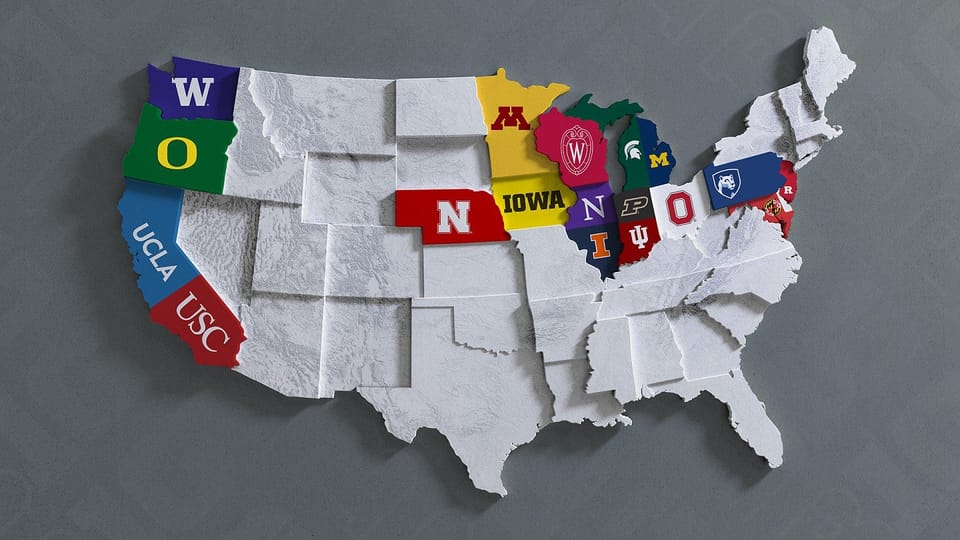
Minority Report
In taking on my current role as secretary of the university senate, I gave up my vote as a senator. While it has taken some time, given my constitutional fondness for debate and conversation, I also keep my opinions off the floor as much as possible. I'll share my opinion as a non-voting senator with any who ask, but it is the senate representatives of our faculty, staff, and student senators who should lead the conversation.
"Minority report" will be my place to share my thoughts about issues being discussed in university senate or faculty council—especially when (as it often the case this year) I find I hold a minority opinion. As always, all opinions are exclusively my own.
This Thursday, the faculty council of the university senate will be considering a “Resolution to Establish a Mutual Defense Compact for the Universities of the Big Ten Academic Alliance in Defense of Academic Freedom, Institutional Integrity, and the Research Enterprise.” This “Mutual Defense Compact” began its life at Rutgers University’s senate, where it was passed on March 28. Afterwards, one Rutgers university senator involved in the push for the resolution declared:
People are just feeling like there's something they can hang their hats on that's hopeful. Individuals who are concerned about higher education, who are involved in it or connected to it—we're looking to something like this from a big university who can step out and say, 'Let's get something going here to blockade against these attacks.'
A few days after the resolution passed their senate, I was on the Rutgers campus for unrelated meetings. By this time it was clear this resolution—written by Rutgers senators with no consultation with senators at other Big10 institutions—would be coming to all our senates before long. It was also clear that the resolution was dead on arrival with leadership, at the very institution that had first signed on. Rutgers President Jonathan Holloway rightly pointed out to his senate on April 10 that his lame duck status made it impossible for him to either commit resources to this or to be in any position to forge any kind of “compact” with other presidents.
What he did not say was something far more relevant than appeals to his lame duck status. The resolution itself asks universities to engage in actions that are, on the face of it, impossible—if not illegal. And being that the core demands of the compact cannot be complied with, what is gained by making these demands on university presidents? If nothing is gained, aside from giving rightfully angry and scared faculty a sense of agency, then we must also consider the risks such a resolution brings with it.
To be clear, institutions of higher education across the country need to work to pool information on the constantly evolving assault on higher education, and to share best practices for protecting international students, vital research projects, and the jobs of faculty, staff, and postdocs. Most of this is already occurring, as leaders across higher education consult with each other to try and understand the chaos that has been unleashed at their gates. But any defensive strategy must necessarily be a quiet one, for one obvious reason: if university leaders say how they are working to protect international students and targeted research programs or any of the rest of it, they tell those looking for reasons to attack higher education how they are working to protect international students and targeted research programs and all of the rest of it.
I get it. I want to know it all too. I want to be shown everything that proves that our universities are doing everything they can to preserve our jobs and our research and our core mission—and even from my relatively privileged position of access to university leaders and Board I don’t know much. But I do trust. Sure, I wonder if I would agree with their approach if I knew the details, but I do not doubt that they are working tirelessly on behalf of the university’s interests as they see them. That benefit of the doubt is the fundamental foundation from which any model of university governance must operate. I expect leadership to extend the same benefit of the doubt to myself and my constituent senate leaders representing faculty, staff, and students.
But trust and benefit of the doubt are in exceedingly short supply on all sides. When the storm began, I had fantasies of our constitutionally divided community being galvanized into unity of purpose—however temporary—by the crisis. After all, my university had experienced such unity, all too briefly, in response to the COVID pandemic in 2020. And in the science fiction novels I consume to escape from this reality, there is nothing like an alien invasion to bring together even hardened earthlings into cooperative action.
In this crisis in higher education, however, the external threat has only served to increase distrust and divisions—even creating new ones that were not there previously. I will think more about why this is so in a future entry. For now, suffice it to say that the same energies that brought about this current moment in our national history—social media and its populist soundbites, the wholesale embrace of conspiracy theory, the presumption that everyone is ally or foe, and the appeal to emotion over reason—are infecting discourse even in higher education, the one space that should be inoculated.
Passing this resolution will, at best, do nothing. Nothing to increase the communication and trust necessary for university shared governance to function. Nothing to strengthen the confidence of our universities in their senates. Nothing to strengthen our positions with legislators. Indeed, this is my dearest wish: that it will do nothing to make things worse, because it can do nothing to make things better.
There is a real possibility however that it will make some things measurably worse.
Unable to fulfill with the demands of the resolution, university leaders and senates will only drift further into mutual distrust. Outside forces at the state or national level looking for talking points to continue their attacks on higher education will only find more fuel for their torches. And when those attacks come and we turn to the other universities that have signed on to this for support, what will we receive? At best, the social media equivalent of “thoughts and prayers,” because there is nothing else to give.
Of course, all of the above presumes that one has read the resolution and still thinks it is a good idea. I have learned over the past week that most who support it have not made it into the guts of the document, so I want to spend some time there for those who remain unconvinced by my declaration that this is dead on arrival because it is calling on the university to engage in acts that are in violation of state law and university policies.
The resolution itself calls upon public state institutions to commit university dollars and resources to universities in other states who find themselves under assault from the federal government. Here are the two statements from the resolution that get to the heart of the matter:
Be it further resolved that, under this compact, all participating institutions shall commit meaningful funding to a shared or distributed defense fund. This fund shall be used to provide immediate and strategic support to any member institution under direct political or legal infringement;
Be it further resolved that, participating institutions shall make available, at the request of the institution under direct political infringement, the services of their legal counsel, governance experts, and public affairs offices to coordinate a unified and vigorous response, including but not limited to: Legal representation and countersuit actions; strategic public communication; amicus briefs and expert testimony; legislative advocacy and coalition-building; related topical research as needed.
Repeatedly over the last few days, veteran faculty colleagues have approached me about the resolution, confident in my shared enthusiasm. When I point to the above language and ask them how that might work, enthusiasm usually cools quickly. And for good reasons.
First, the resolution calls on Big10 institutions, sixteen of which are state universities, to “commit meaningful funding” to a shared defense fund. There is no state legislature in even the bluest state that is going to be okay with state dollars being spent in the service of another state’s institution. In fact, doing so would be an illegal misappropriation of state funds. Let’s look at some places in Ohio law that make this clear.
Let’s start with Article VIII, Section 6 of the state constitution, which prohibits the state from lending its credit to or in aid of any private individual, association, or corporation. While this provision specifies private entities, I would suggest that its principle is clear, and its omission of the prohibition against raising money for another state is solely because it would have never occurred to anyone writing this document that such a thing would even be considered.
Regardless, all of this gets much more specific when we get into the Ohio Revised Code, starting with ORC §3345.81, which outlines the specific goals required in the management and investment of institutional resources for state universities. ORC §126.21 – 126.26 outline the budgeting and appropriation processes for state institutions, which include requirements for transparency and accountability in the use of public funds.
In Ohio, as in many of our fellow public institutions, our state allocations are controlled by the Ohio General Assembly, which means any use of these funds outside of specific guidelines in the Code would require approval from the legislature and legal guidance from the state’s Attorney General. In the case of a republican-controlled state like Ohio, this is a non-starter. The Attorney General of Ohio, who is also the chief legal authority over all public universities, has made it clear that there shall be no concerted actions by Ohio’s public institutions against the actions of the current administration.
Of course, restrictions on the use of university funds are woven deep into statute and state code—including the specific parts of the state revised code that are our university faculty rules. I could outline all the legal and policy roadblocks along the way towards realizing what is called for here—from state level to the rules and policies governing the university treasurer. But for now suffice it to say it is not possible to do this in a way that is in accordance with law and policy.

I have been told more than once that my attention to such niceties of law and policy is naysaying at best and reactionary at worst. Such sentiments seem widely shared at the moment. A senate leader at another institution told me yesterday that after they detailed all the reasons to their senate colleagues why this can't actually happen, the senators bristled at the idea that "bureaucracy" could stand in the way of the solutions proposed. Where there’s a will, there’s a way, and if we build it pass it, they will be obliged to find that way.
So, for the sake of speculations into parallel worlds where state law does not govern the actions of state institutions, let’s set aside these killjoy obstacles and imagine that this could be done. All external obstacles removed, where will we look for the required “meaningful funding” to pool towards this defense compact?
Let’s look at the university budget. Since it is the one I know best, I will use my own institution's budget for Fiscal Year 2025 as the resource from which I hope to find this meaningful funding. While every university has differences in their budget models, all of them are bound by similar considerations that will make the institution-specific example below translate across the Big10.
In FY25, which began in July 2024, Ohio State's budget $10.4 billion. At the highest birds-eye view, it breaks down as follows:
- General and Designated Funds (unrestricted): $2.56 billion
- Tuition and student fees
- State Share of Instruction
- Short-term interest income
- Cost allocations from earnings funds and the Health System
- Earnings Funds (expected to support specific services): $672.9 million
- Auxiliary earnings (e.g., housing, dining, athletics ticket revenue)
- Departmental earnings (e.g., instructional clinic revenue, lab services)
- Endowment and Development Funds (restricted based on donor gift agreements): $298 million
- Current use gifts
- Endowment income and distributions
- Grants and Contracts (restricted to projects or programs stipulated by grantor): $1.22 billion
- Federal, state, and private grants and contracts
Most of the rest of the operational funding at my university exists on the medical campus side—roughly $5.5 billion. Our medical campus is a massive operation, and, like Athletics at Ohio State, it is also self-funding—a parallel ecosystem with its own revenue from one year covering its considerable outlays from the next. We are fortunate that our medical and athletics operations are self-sustaining. These revenue sources are already called for to service the expenses of these massive enterprises, including patient care and a medical research mission already under severe threat.
Which leaves us then with roughly 5 billion total. Surely “considerable funds” can be found in this large pool of money.
Let’s look first in the General and Designated Funds. General Funds at my institution (and many others) are distributed according to a Responsibility Center Management (RCM) budget model. I have many issues with the version of this budget model we use here, but the basic principle is a good one. The OSU model is described at length on p. 21 of the University’s FY2025 Financial Plan, but in its simplest formulation it is a system whereby money is distributed at the start of the budget year to each of colleges at the university, based on the rolling average of the previous two years’ enrollments/credit hours. Which is to say, this technically “unrestricted” money is the lifeblood that allows colleges and the departments to pay their staff and faculty, teach their classes, and, well, exist. A “considerable fund” drawn from this pool means programs shuttered and jobs lost.
I assume we don’t need to dwell on Grants and Contracts from the above list, as we know these are the most heavily restricted of all university funds, able to be used solely in support of the project being funded. We also know how much of this support from the federal government—far and away the largest contributor to grants at research universities across the country—has been canceled or put in doubt. There is nothing here that is available to fund our peer institutions, and in fact it is losses in this category that are at the heart of the crisis.
The smaller category of Earnings Funds above is also restricted by the nature of the revenue collected. These are monies attached to things such as student activity fees, room and board charges, lab fees etc. That is, these are specific services for which students are paying, and which must be provided.
And then there is the Endowment. At 7.9 billion, my university has one of the larger total endowments in the Big10, behind Northwestern and USC, both private, and the University of Michigan.
The vast majority of all endowment funds are tied up by gift agreements with donors, restricting how and when they can be used. In addition the bulk of any total endowment exists in the form of principal, locked away to generate the interest—the spendable portion of the endowment. So for example, if I gave $100,000 to a university establish a student scholarship, the $100,000 gift would be invested. A fixed amount (usually something between 3-5%, or 3-5K) would be distributed each year to fund the scholarship for the student. Anything extra resulting from the investments of those funds would be returned to the principal with the goal of growing the annual payout—the scholarship itself—over time.
Still, my 100K is counted as part of that total endowment, even if only $3-5K is liquid each year. But that 3-5K is far from discretionary, as I will have entered into an agreement with the university limiting the use of the funds to support one student per year. Assuming roughly 3% of the 7.9 billion is liquid in any given year, we have roughly $237 million. But all but a few million of this is allocated according to donor wishes, which neither the donor nor the institution can change easily or on a whim.
One of the biggest surprises when digging deep into a public university budget on a sunny afternoon (as we all do, I am sure), is how little there is anywhere in all the massive numbers that is not already distributed or otherwise restricted. When I worked for a well-heeled private college, I had a fantasy that buckets of money were stashed around in some c-suite waiting for the right ask at the right time to be handed over. I had many asks, and none of them were successful. While they might well have been blowing me off (and most of my suggestions were not in fact good ideas) I now understand that they weren’t lying about the money not being available to, say, build a mountain in central Iowa (that was one of my best ideas).
A university that has buckets of money around to hand over is not doing its fiduciary duty. Anything not held back at the start for central administration—and at my university this amount is shockingly small—is in the hands of those who will put it to work in the coming year in things like paying salaries, supporting instruction, maintaining buildings, upgrading equipment, or lobbying the legislature as part of the biennial budget season.
It must also be added that the conditions that inspired the “Mutual Defense Compact” are in fact the reasons universities must be especially cautious at this moment with any and all discretionary funds. Depending on how things play out in the months ahead—with the proposed slashing of indirect costs to 15%, not to mention the myriad of federal grants and projects canceled outright—research universities will face severe shortfalls in the funds needed to sustain research projects and to support many, many jobs. Any chance of getting through the next couple of years without layoffs, retrenchments, and/or furloughs will depend on judicious and deliberate distributions, where possible, of the small portions of funds that might possibly be freed up for this emergency.
So, it can’t be done, even if, legally, it could be done. Which makes the fantasies as to what it will accomplish all the more outlandish. “It would link the universities, and it would provide a lot of support for faculty,” Indiana psychology professor emeritus Steven Sherman declared after the resolution passed in Bloomington. “I know quite a few faculty who’ve had their grants suddenly stopped in midstream.”
How Prof. Sherman envisions this compact will provide support to the many hundreds of faculty who’ve had grants stopped is unclear. We don’t even know the extent of the funding casualties yet, but we do know that every institution in the Big10 has been impacted. And every institution in the Big10 is trying to ensure that the staff, research faculty, and postdocs attached to these grants are able to be paid, and to trying to keep the grad students involved in these projects from having their educations and careers derailed. How will a community of 18 universities, all suffering from the same injuries, be able to provide support to the others, other than the ways i they are already doing so: pooling information, sharing strategies for mitigation and support, and sending their government affairs offices out to try and change minds before it is too late. The idea that with this compact a faculty member who lost their funding could reach out and apply for relief from the collective is, frankly, cruelly naive.
University of Michigan law professor Sam Bagenstos’s response to the passage of the “compact” at his university gets closer to what I believe remains the honest core of the resolution:
The problem is that what may be individually rational for any one institution or even for every institution taken individually is incredibly harmful to the academy as a whole, and so there needs to be some mechanism by which the various colleges and universities can commit that they are going to stand together. And the idea of a mutual defense compact is to commit that the universities will stand together and get rid of the problem of collective action that they have when the administration goes after universities one at a time.
I appreciate what Prof. Bagenstos is envisioning here, and I find his argument on behalf of the compact the most honest and compelling of any I have heard. He is less imagining a pooling of funds as he is a commitment that no member institution of this consortium will negotiate with the federal government alone, making concessions that, while manageable for one university, might be devastating for another. I have written here of the devastating blow that Columbia’s submission to the administration dealt to all of us in higher education. What Prof. Bagenstos is calling for is a commitment among the Big10 institutions to stand together and not let the administration pit us against each other.
I wish the resolution had called for this, and only this. Although I know the universities’ boards and presidents are bound to put their own institution’s needs first, I think on the whole the principle here is something all could get behind even if it could not be publicly embraced. In fact, I suspect that these are conversations happening among the leaders in the Big10, the AAU, and other configurations in which universities regularly engage with each other. I could vote for a plea to our universities to speak to each other before making decisions that might have dire consequences for another university. This is a solid ask, even as we recognize the limits of any such commitment if the crisis devolves in ways we cannot yet anticipate. Such a commitment of fellowship would not require allocation of state funds or asking university lawyers to represent other universities with whom they do not have attorney-client privilege and in states where they are not licensed to practice.
Sadly, however, this is not what the resolution calls for.

As much as I like what he is after, the obstacle to Prof. Bagenstos' creative interpretation of the called-for compact is precisely what he imagines the compact will make disappear: the profound differences in mission, community, finances, and institution structures that define the 18 universities in the Big Ten conference. Our universities are large (excepting our lil' friend Northwestern), mostly public (excepting Northwestern and USC), and all are members of the Association of American Universities (AAU) and all play each other throughout the year in NCAA sports. That's as close as we can get to commonalities. Six are in solidly red states. Two are in purple states which have swung red in presidential elections. Some universities are financially secure, while others are facing massive budget shortfalls even before the current crisis. Some have no faculty or graduate student unions. Some have collective bargaining agreements covering almost every corner of the institution. And so on.
Each university will have to devise a strategy unique to its own political, economic, and institutional circumstances. Any fellowship will come not from the erasure of those differences but out of the search for common ground once the priorities of each university have been shared. The Venn diagram will ultimately reveal a small proportion for each university that can be addressed through a shared strategy, but it is that common ground that can provide the leverage to make this fellowship meaningful.
And, it needs to be repeated, if we remove from the resolution the impossible call to share financial and legal resources and instead focus solely on the commitment to finding ground on which to dig in our collective heels, then it is already happening. Presidents and Provosts consult with their Big Ten counterparts, as do senate leaders and numerous other peer groups throughout the Big Ten Academic Alliance and in informal peer groups. When I talk with colleagues at other Big Ten institutions, we share concerns and information, and knowing what is happening at a peer institution is invaluable to have a sense as to what might be coming our way and how we might best prepare. But always in such exchanges we are keenly aware how very much our institutions differ even as we face a similar emergency.
This resolution is a natural response to an external threat. When we feel powerless and vulnerable in the face of a bully, having a united team makes the situation feel less scary. The idea that together we can be stronger than we are apart is not wrong. But any such team-up needs to start with a stable foundation of trust internally withing the institution. If we can’t trust that our own administrations are working on behalf of the short and longterm survival of our institutions, then what does it mean to make demands of them?
Of course, I would throw the same charges back at administrations. Leaders complain about the tendency of faculty to drift into conspiracy theory, and then they withhold the communication necessary to prevent conspiracies from taking root. In a crisis, university leaders' instincts are to go into bunker mode, controlling communications and talking only to each other. And then they wonder why the faculty and students are skeptical that their interests are being consulted. Trust, benefit of the doubt, and the risk that such trust entails, is something all of us—faculty and administrators especially—are failing to uphold.
Before we create any imaginary superhero fellowship, each campus needs to focus on now is one internal to their own internal fellowship. If we cannot work together in our own institutions, extending to each other trust and benefit of the doubt across our vast structures, then all of this is pointless. The war is already lost.
This goal is one I believe in deeply. It is the fundamental founding principle of shared governance that we are stronger together than we are individually. But that only works if each institution has galvanized itself across its constituent groups around principles of trust and communication. The historic and often knee-jerk suspicion between faculty and administrators must be set aside if we are to work together—faculty, staff, students, and administrators. Administrators must trust faculty enough to communicate as openly as possible with them. Faculty must trust administrators sufficiently to accept that they cannot share everything (or, in a crisis, most things). That is just a beginning, but it is the necessary precondition. Only then can we establish the conditions that would allow a meaningful defense of the whole.
Fortunately, we have the machinery at hand to enable this to take place, if the will to put aside ancient enmities and suspicions can be found. The machinery is our senates, the systems of shared governance that each of our institutions has. The very senates that are being turned into engines for generating ever more resolutions making impossible demands at an impossible time and undermining the fundamental function of shared governance itself. There is a time and place for resolution—including in senates. I myself have helped write some over the years. But this is not a time to lean in on the “resolutionary” role of senates, demanding the university do what it cannot—by law, policy, and others inescapable realities. This is a time to lean in on the very fellowship and unity of purpose this resolution itself seeks to will into being.
Subscribe (free!) to receive the latest updates


Member discussion